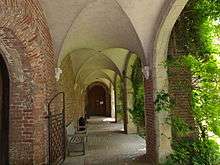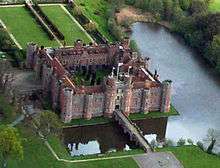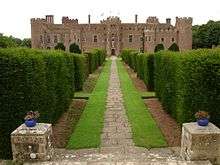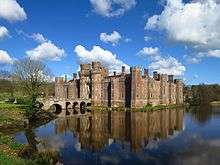Herstmonceux Castle
| Herstmonceux Castle | |
|---|---|
| East Sussex, England | |
|
Herstmonceux Castle, seen from the south-east | |
 Herstmonceux Castle | |
| Coordinates | grid reference TQ64511046 |
| Type | Tudor mansion |
| Site information | |
| Owner | Queen's University, Canada |
| Condition | Intact, used as a study centre |
| Site history | |
| Materials | Brick |
Herstmonceux Castle is a brick-built castle near Herstmonceux, East Sussex, England. From 1957 to 1988 its grounds were the home of the Royal Observatory, Greenwich. Today it is used by the Bader International Study Centre of Queen's University, Canada.
Significance
Herstmonceux Castle is one of the oldest significant brick buildings still standing in England; brick was an unusual material for the time in Britain. The builders of Herstmonceux Castle concentrated more on grandeur and comfort than on defence.
Herstmonceux Castle is home to events throughout the year, including the annual England's Medieval Festival on August Bank Holiday weekend.
The parks and gardens of Herstmonceux Castle and Place are Grade II* listed on the Register of Historic Parks and Gardens.[1] Other listed structures on the Herstmonceux estate include the Grade II listed walled garden to the north of the castle,[2] and the Grade II* listed telescopes and workshops of the Herstmonceux Science Centre.[3]
History
Early history
The first written evidence of the existence of the Herst settlement appears in William the Conqueror's Domesday Book which reports that one of William's closest supporters granted tenancy of the manor at Herst to a man named ‘Wilbert'. By the end of the twelfth century, the family at the manor house at Herst had considerable status. Written accounts mention a lady called Idonea de Herst, who married a Norman nobleman named Ingelram de Monceux. Around this time, the manor began to be called the “Herst of the Monceux”, a name that eventually became Herstmonceux.
A descendant of the Monceux family, Roger Fiennes, was ultimately responsible for the construction of Herstmonceux Castle in the County of Sussex. Sir Roger was appointed Treasurer of the Household of Henry VI of England and needed a house fitting a man of his position, so construction of the castle on the site of the old manor house began in 1441. It was this position as treasurer which enabled him to afford the £3,800 construction of the original castle. The result is not a defensive structure, but a palatial residence in a self-consciously archaising castle style.

In 1541, Sir Thomas Fiennes, Lord Dacre, was tried for murder and robbery of the King's deer after his poaching exploits on a neighboring estate resulted in the death of a gamekeeper. He was convicted and hanged as a commoner, and the Herstmonceux estate was temporarily confiscated by Henry VIII of England, but was restored to the Fiennes family during the reign of one of Henry's children.[4]
The profligacy of the 15th Baron Dacre, heir to the Fiennes family, forced him to sell in 1708 to George Naylor, a lawyer of Lincoln’s Inn in London. Bethaia Naylor, who became the heiress of Herstmonceux on the death of her brother's only daughter, married Francis Hare and produced son Francis, who inherited in turn his mother's property. The castle eventually came into the possession of Robert Hare-Naylor, who, upon the nagging of his second wife, Henrietta Henckell, followed the architect Samuel Wyatt’s advice to reduce the Castle to a picturesque ruin by demolishing the interior.[5] Thomas Lennard, 17th Baron Dacre, was sufficiently exercised as to commission James Lamberts Jnr of Lewes (1741-1799) to record the building in 1776.[6][7][8] The castle was dismantled in 1777 leaving the exterior walls standing and remained a ruin until the early 20th century
20th century restoration
Radical restoration work was undertaken by Colonel Lowther in 1913 to transform the ruined building into a residence and completed for Sir Paul Latham in 1933 by the architect, Walter Godfrey. The existing interiors largely date to this period, incorporating architectural antiques from England and France. The one major change in planning was the combination of the four internal courtyards into one large one. The restoration work, regarded as the apex of Godfrey's architectural achievement, was described by the critic Nikolaus Pevsner as executed 'exemplarily'.
Royal Greenwich Observatory

The property passed through the hands of private owners until it was sold in 1946 to the Admiralty. In 1957 the Herstmonceux Castle grounds became the home of the Royal Greenwich Observatory and remained so until 1988, when the observatory relocated to Cambridge.
Several of the telescopes remain but the largest telescope, the 100 inch (254 cm) aperture Isaac Newton Telescope was moved to La Palma, Canary Islands in the 1970s. The estate provides housing to the Equatorial Telescope Buildings, which have been converted to an interactive science centre for schoolchildren. The empty dome for the Newton Telescope remains on this site and is a landmark, visible from afar.
University study centre

In 1992 Alfred Bader, an alumnus of Queen's University, Ontario, learned of the castle's vacancy and offered to purchase the castle for his wife; she declined, joking that there would be "too many rooms to clean".[9] Bader later contacted then-Principal of Queen's University, David Chadwick Smith, asking if a castle might fit into the school's plans, possibly as an international study centre.
In 1994, after intensive renovations, the Queen's International Study Centre was opened. It hosts primarily undergraduate students studying arts or commerce through the Canadian University Study Abroad Program (CUSAP), as well as graduate students studying Public International Law or International Business Law. In late January 2009, the ISC was renamed the Bader International Study Centre.
Appearances in fiction
The castle was used for filming part of The Silver Chair, a 1990 BBC adaptation of the book (one of The Chronicles of Narnia) by C. S. Lewis. The castle and gardens were used by comedians Reeves and Mortimer for one of their Mulligan and O'Hare sketches. In August 2002, The Coca-Cola Company rented the castle for use as part of a prize in a Harry Potter-themed sweepstakes -- the castle served as "Hogwarts" in a day of Harry Potter-related activities for the sweepstakes winners. A "painting" of the castle was used as a magical cursed object in the U.S. television show Charmed - episode 2.3 "The Painted World".
Owners of Herstmonceux Manor/Castle



- 1066 - Edmer, a priest.
- 1086 - Wilbert, tenant-in-chief.
- c.1200 - Idonea de Herst (married Ingelram de Monceux).
- 1211 - Their son Waleran de Monceux.
- 1216 - His son William de Monceux.
- ? - His son Waleran de Monceux.
- 1279 - His son John de Monceux.
- 1302 - His son John de Monceux.
- 1316 - His son John de Monceux.
- 1330 - His sister Maud de Monceux (married Sir John Fiennes)
- 1351 - The eldest son William Fiennes.
- 1359 - His son Sir William Fiennes.
- 1402 - His son Sir Roger Fiennes (built Herstmonceux castle)
- 1449 - His son Sir Richard Fiennes (married Joan Dacre, 7th Baroness Dacre)
- 1483 - His grandson Sir Thomas Fiennes.
- 1533 - Sir Thomas Fiennes.
- 1541 - His eldest son Thomas Fiennes.
- 1553 - His brother Gregory Fiennes.
- 1594 - His sister Margaret Fiennes (married Sampson Leonard).
- 1612 - Their son Sir Henry Leonard.
- 1616 - His son Richard Leonard.
- 1630 - His son Francis Leonard.
- 1662 - His son Thomas Leonard.
- 1708 - Estate purchased by George Naylor for £38,215.
- 1730 - His nephew Francis Naylor.
- 1775 - His half-brother Robert Hare who demolished the castle in 1776.
- ? - His son Francis Hare Naylor.
- 1807 - Purchased by Thomas Read Kemp.
- 1819 - Purchased for John Gillon MP.
- 1846 - Purchased by Herbet Barrett Curteis MP.
- ? - His son Herbert Mascall Curteis.
- ? - His son Herbert Curteis.
- 1911 - Purchased by Lieutenant-Colonel Claude Lowther (restoration begins).
- 1929 - Purchased by Reginald Lawson.
- 1932 - Purchased by Sir Paul Latham (completes restoration under Walter Godfrey).
- 1946 - Purchased by H.M. Admiralty for The Royal Observatory.
- 1965 - Transferred to the Science Research Council.
- 1989 - Purchased by James Developments, transfers to a receiver, the Guinness Mahon Bank.
- 1993 - Purchased for Queen's University, Ontario (Canada) as a gift from Drs. Alfred and Isabel Bader.
See also
References
- Notes
- ↑ Historic England, "Herstmonceux Castle and Place (1000231)", National Heritage List for England, retrieved 26 September 2016
- ↑ Historic England, "Walled Garden to North of Herstmonceux Castle (1243641)", National Heritage List for England, retrieved 26 September 2016
- ↑ Historic England, "Herstmonceux Science Centre (1391813)", National Heritage List for England, retrieved 26 September 2016
- ↑ Ranulph Fiennes, Mad Dogs and Englishmen: An Expedition Round My Family (2009)
- ↑ DNB00: "Hare-Naylor, Francis"
- ↑ familylambert.net: "JAMES LAMBERT 1725-1788 and 1741-1799"
- ↑ "The drawings of Herstmonceux Castle by James Lambert, senior and junior, 1776–7", SUSSEX ARCHAEOLOGICAL COLLECTIONS 148 (2010), 177–81
- ↑ artfund.org: "Leather bound folio of 77 watercolours and drawings of Sussex by James Lambert Senior"
- ↑ Royal Institute of Chemistry 1993, p. 922
- Bibliography
- Royal Institute of Chemistry (1993), Chemistry in Britain, Chemical Education Trust Fund for the Chemical Society and the Royal Institute of Chemistry, 29 Missing or empty
|title=(help) - John Goodall in Burlington Magazine (August 2004).
- Nairn, Ian; Nikolaus Pevsner (1965). Sussex (Buildings of England series). London: Penguin Books.
External links
| Wikimedia Commons has media related to Herstmonceux Castle. |
| Wikisource has the text of the 1911 Encyclopædia Britannica article Hurstmonceaux. |
- Official website
- Queen's University (Canada)'s Bader International Study Centre at Herstmonceux Castle
- The Observatory Science Centre, Herstmonceux
- A Personal History of the Royal Greenwich Observatory at Herstmonceux Castle, 1948-1990 by George Wilkins, a former member of staff
Coordinates: 50°52′10″N 0°20′19″E / 50.8695°N 0.3387°E
